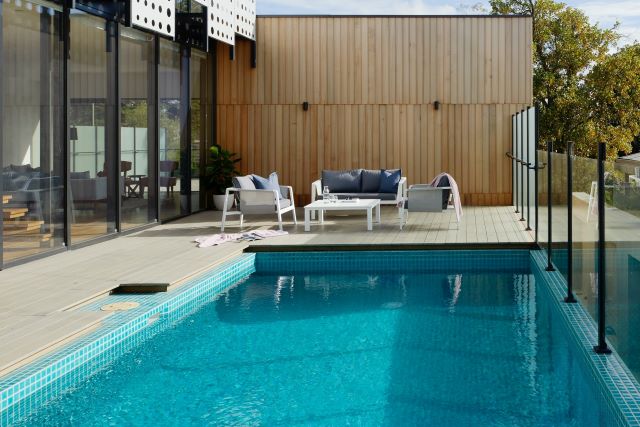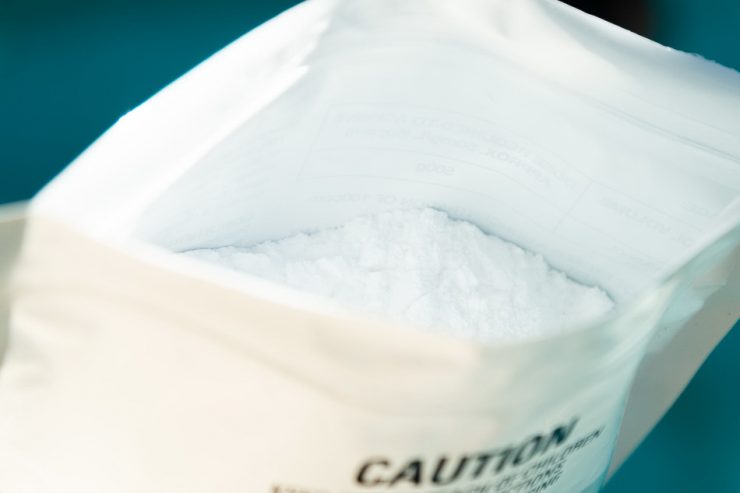If you’ve owned a pool for any length of time you’ll likely already know that muriatic acid and cyanuric acid are both common chemicals used in swimming pools. But is muriatic acid the same as cyanuric acid? And what’s the difference between cyanuric acid and muriatic acid?
In this article we’ll explain what muriatic acid is and also what cyanuric acid is as well as what each of these chemicals does and how to use them in your pool.

Cyanuric Acid vs Muriatic Acid – What’s the Difference?
The short answer is that muriatic acid and cyanuric acid are NOT the same when it comes to your pool.
Yes both cyanuric acid and muriatic acid are both acids but they serve different purposes for the pool owner. Cyanuric acid has the chemical formula CNOH, whereas muriatic acid is a diluted form of hydrochloric acid, HCI.
Cyanuric acid for swimming pools (or CYA for short) is used for stabilizing chlorine or protecting it from degradation by the Sun’s UV rays. You can read more on Cyanuric Acid here.
Muriatic acid on the other hand is used for a number of purposes including reducing pH and alkalinity, cleaning stains and cleaning filters.
The two are definitely not interchangeable and you cannot substitute cyanuric acid for muriatic acid or vice versa.
What is the Purpose of Muriatic Acid in Swimming Pools?
Muriatic acid is most commonly used by pool owners to reduce pH levels. If you have a high pH level, then you’ll need muriatic acid. Specifically, muriatic acid when added to swimming pools, will decrease the pH level and alkalinity in the water.
The products pool stores carry and call pH Decreasers (which are mostly Sodium Bisulphate) are different from muriatic acid, they do a similar job.
pH and alkalinity are one of the most important things to monitor when it comes to your pool. Get this wrong and the water can irritate and sting eyes and skin and you also risk your pool being more susceptible to waterborne diseases – chlorine needs the correct pH level (7.2 – 7.6) to work effectively.
Muriatic Acid is stronger than Sodium Bisulphate and will decrease pH levels and alkalinity faster. It’s simply added to the pool to bring down the pH levels.
When adding an acid to your pool you should always dilute it in water first. Use fresh tap water and not pool water. Acids can have strong dangerous reactions if you fail to do this.
In addition to lowering your pool’s pH levels, you can also use muriatic acid for cleaning rust stains off of pools and surrounds, cleaning grout and also for cleaning pool filters. It’s a very powerful cleaner.
Note: don’t use it for cleaning vinyl pools or pools with liners. It is too strong for this purpose.
What is the Purpose of Cyanuric Acid in Swimming Pools?

Chlorine is the most common sanitizer for swimming pools. It helps to keep algae away and minimizes bad bacteria in the water.
However there’s a big drawback of chlorine. When exposed to UV light, it degrades and quickly loses its effectiveness. In fact, after only a few hours, chlorine can lose half its effectiveness, meaning all that expensive chlorine you just added to your pool has been wasted.
Enter Cyanuric acid (CYA) or chlorine stabilizer. CYA is used to preserve and protect the active chlorine. It’s added to the pool water or in some cases, chlorine comes premixed with CYA.
The cyanuric acid works by forming a bond with the chlorine. Once this bond is formed, UV light no longer affects chlorine. Now your chlorine can work effectively and will last exponentially longer.
FAQ’s
Is Muriatic Acid Dangerous?
When it comes to handling muriatic acid great caution should be taken. It is a dangerous chemical to handle and will cause severe burns if your skin comes in contact with it.
The fumes can also burn your nose and lung linings and contact to eyes could blind you or cause severe damage.
Always take proper precautions when handling. Wear long thick rubber gloves designed for acids, long sleeve clothing, eye protection and always ensure you use it in a well ventilated area.
When adding muriatic acid, as mentioned earlier, always water it down first. Add the acid to the water first and not the water to the acid. A strong reaction could occur if you don’t do this. You should also use fresh water and not pool water.
How About Swimming? Is Muriatic Acid Safe For Swimming?
Yes if you follow these guidelines:
- Always 30-60 mins for the acid to disperse before swimming in your pool
- Check the pH of your pool is between 7.2-7.4
Does Muriatic Acid Affect Cyanuric Acid?
Both muriatic acid and cyanuric acid can be used in your pool with minimal adverse effects on each other. Although, as with any chemical, it’s best not to dump a whole lot into your pool at the one time or mix chemicals.
Add the chemicals separately waiting a few minutes in-between adding.
It’s always best to add small amounts of chemicals at a time. Then retesting with a pool test kit will ensure you don’t overdo it, which could cause additional problems.
Is Muriatic Acid the Same as Hydrochloric Acid?
Muriatic acid and hydrochloric acid are essentially the same. Muriatic acid is a watered down version of hydrochloric acid. It’s not as expensive as hydrochloric acid since it’s not as pure.
Although in the pool industry, the names muriatic acid and hydrochloric acid are often used interchangeably. They both do the same job and lower pH and alkalinity.
How Long After Adding Acid Can You Swim?
After adding muriatic acid to your pool you should wait 30-60 minutes before swimming.
After you first add muriatic acid, or any chemical for that matter, it will be a little concentrated where you added it. Swimming in concentrated areas of muriatic acid could irritate your skin.
Waiting 30-60 minutes will allow the muriatic acid, or other chemicals, to mix in with the pool water and dilute enough to be safe to swim. You can speed up the mixing process by running your pool pump and also stirring the water with a pool net.
Summary
Now you know what the difference between muriatic acid and cyanuric acid is. They are definitely not the same thing and cannot be substituted for each other.
Muriatic acid is used to lower the alkalinity and pH of your pool whereas cyanuric acid is used to stabilize the chlorine and will not noticeably lower pH.
Muriatic acid can also be used for cleaning grout, stains and it’s also great for cleaning gummed up pool filters.
Do you use both cyanuric acid and muriatic acid? In what ways?
Further reading:
Cyanuric Acid for Pools – The Complete Guide for Pool Owners

